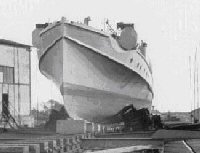This is the story of S-130, the last surviving German E-Boat from WWII. Called “E-Boats” by the British, these fast torpedo craft are more properly called Schnell-boote, or S-Boot and it is this convention that is adopted in the account that follows. It is the tale of one little ship and her course through the momentous events of the Second World War, the Cold War that followed and the re-birth of the German Navy. Most of all, it is a story about people – heroes, villains, pirates and spies, embroiled in a tale more exciting than any contemporary novel. But first, a little history……..
The technical development of the S-Boot is a tribute to the imagination, determination and resourcefulness of German engineers. Although the treaty of Versailles was meant to prevent Germany from taking up arms in a war of aggression, its practical effect was to stimulate an ingenious and modernistic arms development programme. Turning obstacles into advantages, German engineers designed weapons that both outwitted the restrictions of the Versailles treaty and capitalised on new technologies and tactics that could enable a small, lightly equipped nation to defeat a more powerful but anachronistic enemy. The rapid defeat of France in 1940, despite its overwhelming numerical superiority over Germany in weapons and troops, provided total vindication of this programme.

The S-Boot is a classic example of Germany's Versailles-influenced weapons engineering. Focusing on a boat considered too insignificant by the Allies to be regulated by the treaty, the Germans created a scaled-down warship well-suited for naval Blitzkrieg. Heavily armed and fast, it could inflict great damage on a larger enemy and escape unharmed. Its sturdy design showed great foresight of its future operational role and emphasised high quality over mass production.
From very the beginning of the torpedo boat programme, German Naval Command required boats suited for combat in the demanding conditions of the North Sea, English Channel and Western Approaches. A series of trials with a broad variety of designs began in 1920 under cover of developing a fast "submarine chaser". Most of these initial programmes concentrated on short, planing hulls commonly used for speedboats. This surface-skimming design is ideal for fast boats in calm waters but loses its chief advantage of efficiency when the flat hull bottom slams and “tramps” in a seaway. Furthermore, weight is a critical issue, and the iridescent plume of water created by a planing boat moving at high speed is visible over great distances at night.
In 1928, in light of these limitations and the dismal North Sea weather, the German Naval command elected to concentrate on a round-bottomed, displacement hull. Their attention was drawn to Oheka II, a highly innovative luxury motor yacht built in 1927 by the German boatyard Lürssen for a Jewish banking tycoon who subsequently emigrated to the United States. Her name, "Oheka" originated from a monogram of her owner's name, Otto Herman Kahn. Her round-bottomed hull was 22.5 m long, and displaced 22.5 tons. She reached a top speed of 34 knots, making her the world's fastest boat in her class. |

Oheka II |
In Oheka II, Lürssen overcame many of the drawbacks of the round-bottomed displacement hull. The boat ploughed through the water by the brute force of three 550hp Maybach engines whilst the composite use of wood planks over alloy frames reduced weight. The inefficient tendency for round hulls to "squat" stern-down in the water at high speeds was counterbalanced by a hull form that flattened towards the stern, providing hydrodynamic lift where it was needed.
|
Oheka II's combination of speed, strength and seaworthiness was exactly what the German Naval command wanted so, in November 1929, Lürssen was contracted to build a boat to the same basic design but with two torpedo tubes on the forecastle and a slightly improved top speed. She was to become S-1, the Kriegsmarine's first Schnellboot and the basis for the all other S-Boots built during World War 2.
|
Experimentation with S-1 and the initial batch of five additional boats led to immediate improvements and innovations. For example, beginning with S-7 (1933), the increased reserve buoyancy of a knuckle added at the bow prevented the boat from nosing into waves in foul weather.
|

Round sections and pronounced “knuckle” |